Thermophysiology and Cognitive Performance of Live-Line Workers in High-Temperature and High-Humidity Environments
Abstract
1. Introduction
2. Methods and Materials
2.1. Experimental Equipment
2.2. Participants
2.3. Experimental Program
- (1)
- Investigating the effects of different temperatures (23 ± 0.2 °C, 32 ± 0.2 °C, and 38 ± 0.2 °C) in a high-humidity (RH 75 ± 5%) environment on the physiological parameters of individuals wearing shielding clothing.
- (2)
- (Investigating the effects of different humidity levels (RH 30 ± 5%, RH 50 ± 5%, and RH 75 ± 5%) in a high-temperature (38 ± 0.2 °C) environment on the physiological parameters of individuals wearing shielding clothing.
- (3)
- Investigating the changes in physiological parameters of individuals wearing shielding clothing and regular work attire (e.g., electricians’ typical short-sleeve shirts and long pants) under high-temperature and high-humidity conditions (38 ± 0.2 °C, RH 75 ± 5%).
2.4. Experimental Procedure
2.5. Parameter Measurement
2.6. Statistical Analysis
3. Results
3.1. Core Temperature
3.2. Skin Temperature
3.3. Thermal Sensation
3.4. Sweat, Heart Rate and Blood Oxygen
3.5. Error Rate and Response Time of Cognitive Tests
3.6. Variation in Physiological Parameters of the Human Body Under Different Clothing Conditions
4. Discussion
4.1. Effect of Different Temperatures and Humidity on Body Temperature
4.2. Effect of Different Temperature and Humidity on Physiological Responses
4.3. Effects of Different Temperatures and Humidity on Cognitive Performance
4.4. Limitations and Future Study
5. Conclusions
- (1)
- With the increase in temperature and humidity, the core temperature, heart rate, and thermal sensation scores of participants wearing high-voltage-shielding clothing significantly increased, and were higher compared to participants wearing standard workwear. In cognitive testing, high temperature and humidity conditions significantly reduce task accuracy and response speed. Moreover, more complex tasks exhibit even more significant negative effects.
- (2)
- A heat sensation prediction model for live-line workers based on environmental temperature under high humidity conditions was established to predict human heat sensation through environmental temperature. In the neutral heat sensation range (−0.5~+0.5), the environmental temperature should be within the range of 20.8–25.8 °C.
- (3)
- Another prediction model for heat sensation is based on the average skin temperature under high humidity, aimed at predicting the average skin temperature through human heat sensation. In the neutral heat sensation range (−0.5~+0.5), the average skin temperature should fall within the range of 33.4–34.1 °C.
- (4)
- The shielding clothing significantly inhibits the heat dissipation of the participants, leading to increased heat accumulation within the body compared to normal work clothing. Consequently, live-line workers face higher physiological and cognitive burdens. Therefore, effective cooling measures are urgently needed to ensure their occupational safety and work efficiency. The results of this study provide a theoretical basis for the development of personal protective equipment for live-line workers.
Author Contributions
Funding
Institutional Review Board Statement
Informed Consent Statement
Data Availability Statement
Acknowledgments
Conflicts of Interest
References
- Song, F.; Zhang, G.J.; Ramanathan, V.; Leung, L.R. Trends in surface equivalent potential temperature: A more comprehensive metric for global warming and weather extremes. Proc. Natl. Acad. Sci. USA 2022, 119, e2117832119. [Google Scholar] [CrossRef] [PubMed]
- Jørgensen, L.B.; Ørsted, M.; Malte, H.; Wang, T.; Overgaard, J. Extreme escalation of heat failure rates in ectotherms with global warming. Nature 2022, 611, 93–98. [Google Scholar] [CrossRef]
- Hu, T.; Sun, Y. Projected changes in extreme warm and cold temperatures in China from 1.5 to 5 °C global warming. Int. J. Climatol. 2020, 40, 3942–3953. [Google Scholar] [CrossRef]
- Easterling, D.R.; Meehl, G.A.; Parmesan, C.; Changnon, S.A.; Karl, T.R.; Mearns, L.O. Climate Extremes: Observations, Modeling, and Impacts. Science 2000, 289, 2068–2074. [Google Scholar] [CrossRef]
- Ebi, K.L.; Capon, A.; Berry, P.; Broderick, C.; de Dear, R.; Havenith, G.; Honda, Y.; Kovats, R.S.; Ma, W.; Malik, A.; et al. Hot weather and heat extremes: Health risks. Lancet 2021, 398, 698–708. [Google Scholar] [CrossRef] [PubMed]
- Mao, Y.; Zhu, Y.; Guo, Z.; Zheng, Z.; Fang, Z.; Chen, X. Experimental investigation of the effects of personal protective equipment on thermal comfort in hot environments. Build. Environ. 2022, 222, 109352. [Google Scholar] [CrossRef]
- Xie, Z. Encyclopedia of China: Environmental Science; Encyclopedia of China Press: Beijing, China, 2002. (In Chinese) [Google Scholar]
- He, X. Safety Engineering; China University of Mining and Technology Press: Beijing, China, 2000. (In Chinese) [Google Scholar]
- Zhou, B.; Ding, L.; Chen, B.; Shi, H.; Ao, Y.; Xu, R.; Li, Y. Physiological Characteristics and Operational Performance of Pilots in the High Temperature and Humidity Fighter Cockpit Environments. Sensors 2021, 21, 5798. [Google Scholar] [CrossRef]
- Buzan, J.R.; Huber, M. Moist heat stress on a hotter Earth. Ann. Rev. Earth Planet. Sci. 2020, 48, 623–655. [Google Scholar] [CrossRef]
- Matthews, T. Humid heat and climate change. Prog. Phys. Geogr. Earth Environ. 2018, 42, 391–405. [Google Scholar] [CrossRef]
- Jiang, C.; Zou, D.; Long, C.; Yang, M.; Zhang, Z.; Mei, D. Security warning method and system for worker safety during live-line working. IOP Conf. Ser. Mater. Sci. Eng. 2017, 231, 012007. [Google Scholar] [CrossRef]
- Li, X.; Chow, K.H.; Zhu, Y.; Lin, Y. Evaluating the impacts of high-temperature outdoor working environments on construction labor productivity in China: A case study of rebar workers. Build. Environ. 2016, 95, 42–52. [Google Scholar] [CrossRef]
- Yao, Y.; Lian, Z.; Liu, W.; Shen, Q. Experimental study on physiological responses and thermal comfort under various ambient temperatures. Physiol. Behav. 2008, 93, 310–321. [Google Scholar] [CrossRef] [PubMed]
- Gerhart, H.D.; Fiorentini, A.B.; Storti, K.L.; Alman, R.; Bayles, M.P.; Pesci, L.; Seo, Y. Psychophysiological responses in emergency medical technician students during simulated work activities in a hot environment. Int. J. Environ. Res. Public Health 2020, 17, 3443. [Google Scholar] [CrossRef]
- Geng, J.; Tang, Y.; Zhang, Y.; Shen, K.; Wang, J.; Weng, W. Experimental study on human physiology, subjective responses, and cognitive performance at 20–48 °C. Build. Environ. 2024, 265, 111930. [Google Scholar] [CrossRef]
- Cui, W.; Cao, G.; Park, J.H.; Ouyang, Q.; Zhu, Y. Influence of indoor air temperature on human thermal comfort, motivation and performance. Build. Environ. 2013, 68, 114–122. [Google Scholar] [CrossRef]
- Liu, W.; Zhong, W.; Wargocki, P. Performance, acute health symptoms and physiological responses during exposure to high air temperature and carbon dioxide concentration. Build. Environ. 2017, 114, 96–105. [Google Scholar] [CrossRef]
- Faerevik, H.; Eidsmo Reinertsen, R. Effects of wearing aircrew protective clothing on physiological and cognitive responses under various ambient conditions. Ergonomics 2003, 46, 780–799. [Google Scholar] [CrossRef]
- Saini, R.; Srivastava, K.; Agrawal, S.; Das, R. Cognitive deficits due to thermal stress: An exploratory study on soldiers in deserts. Med. J. Armed. Forces India 2017, 73, 370–374. [Google Scholar] [CrossRef]
- Gaoua, N.; Grantham, J.; Racinais, S.; El Massioui, F. Sensory displeasure reduces complex cognitive performance in the heat. J. Environ. Psychol. 2012, 32, 158–163. [Google Scholar] [CrossRef]
- Tian, X.; Fang, Z.; Liu, W. Decreased humidity improves cognitive performance at extreme high indoor temperature. Indoor Air 2021, 31, 608–627. [Google Scholar] [CrossRef]
- McMorris, T.; Swain, J.; Smith, M.; Corbett, J.; Delves, S.; Sale, C.; Harris, R.C.; Potter, J. Heat stress, plasma concentrations of adrenaline, noradrenaline, 5-hydroxytryptamine and cortisol, mood state and cognitive performance. Int. J. Psychophysiol. 2006, 61, 204–215. [Google Scholar] [CrossRef] [PubMed]
- Ely, B.R.; Sollanek, K.J.; Cheuvront, S.N.; Lieberman, H.R.; Kenefick, R.W. Hypohydration and acute thermal stress affect mood state but not cognition or dynamic postural balance. Eur. J. Appl. Physiol. 2013, 113, 1027–1034. [Google Scholar] [CrossRef] [PubMed]
- Simmons, S.E.; Saxby, B.K.; McGlone, F.P.; Jones, D.A. The effect of passive heating and head cooling on perception, cardiovascular function and cognitive performance in the heat. Eur. J. Appl. Physiol. 2008, 104, 271–280. [Google Scholar] [CrossRef]
- Wang, H.; Xu, Z.; Ge, B.; Li, J. Experimental study on a phase change cooling garment to improve thermal comfort of factory workers. Build. Environ. 2023, 227, 109819. [Google Scholar] [CrossRef]
- Xiao, H. Physiology of Aviation Oxygen Protective Equipment; Military Medical Science Publishing House: Beijing, China, 2005. [Google Scholar]
- Tian, Y.; Li, J.; Ding, L.; Wang, Q.; Ren, Z.; Shi, L.; Xue, L. Evaluation of Operation Ergonomics at High-temperature in the Cockpit. J. Biomed. Eng. 2011, 28, 702–707. (In Chinese) [Google Scholar]
- Ouyang, H. Clothing Hygiene; People’s Army Medical Press: Beijing, China, 1985. (In Chinese) [Google Scholar]
- Xu, J.; Chen, G.; Wang, X.; Chen, Z.; Wang, J.; Lu, Y. Novel Design of a Personal Liquid Cooling Vest for Improving the Thermal Comfort of Pilots Working in Hot Environments. Indoor Air 2023, 2023, 6666182. [Google Scholar] [CrossRef]
- Kim, D.-H.; Bae, G.-T.; Lee, J.-Y. A novel vest with dual functions for firefighters: Combined effects of body cooling and cold fluid ingestion on the alleviation of heat strain. Ind. Health 2020, 58, 91–106. [Google Scholar] [CrossRef]
- Chen, Y.; Tao, M.; Liu, W. High temperature impairs cognitive performance during a moderate intensity activity. Build. Environ. 2020, 186, 107372. [Google Scholar] [CrossRef]
- Kessels, R.P.C.; Hendriks, M.P.H. Neuropsychological Assessment, Encyclopedia of Mental Health, 2nd ed.; Academic Press: Oxford, UK, 2016; pp. 197–201. [Google Scholar]
- Tang, T.; Zhou, X.; Zhang, Y.; Feng, X.; Liu, W.; Fang, Z.; Zheng, Z. Investigation into the thermal comfort and physiological adaptability of outdoor physical training in college students. Sci. Total. Environ. 2022, 839, 155979. [Google Scholar] [CrossRef]
- Kang, Z.; Udayraj; Wan, X.; Wang, F. A new hybrid personal cooling system (HPCS) incorporating insulation pads for thermal comfort management: Experimental validation and parametric study. Build. Environ. 2018, 145, 276–289. [Google Scholar] [CrossRef]
- Shi, X.; Zhu, N.; Zheng, G. The combined effect of temperature, relative humidity and work intensity on human strain in hot and humid environments. Build. Environ. 2013, 69, 72–80. [Google Scholar] [CrossRef]
- Liu, W.; Lian, Z.; Deng, Q.; Liu, Y. Evaluation of calculation methods of mean skin temperature for use in thermal comfort study. Build. Environ. 2011, 46, 478–488. [Google Scholar] [CrossRef]
- Huizenga, C.; Zhang, H.; Arens, E.; Wang, D. Skin and core temperature response to partial- and whole-body heating and cooling. Build. Environ. 2004, 29, 549–558. [Google Scholar] [CrossRef]
- Yeom, D.J.; Delogu, F. Local body skin temperature-driven thermal sensation predictive model for the occupant’s optimum productivity. Build. Environ. 2021, 204, 108196. [Google Scholar] [CrossRef]
- Zhou, B.; Jiao, B.; Chen, B.; Sun, C.; Ding, L.; Ao, Y. Physiological and perceptual responses of exposure to different thermal environments at low pressure (61.6 kPa). Build. Environ. 2022, 226, 109774. [Google Scholar] [CrossRef]
- Liu, W.; Tian, X.; Yang, D.; Deng, Y. Evaluation of individual thermal sensation at raised indoor temperatures based on skin temperature. Build. Environ. 2021, 188, 107486. [Google Scholar] [CrossRef]
- Jin, L.; Zhang, Y.; Zhang, Z. Human responses to high humidity in elevated temperatures for people in hot-humid climates. Build. Environ. 2017, 114, 257–266. [Google Scholar] [CrossRef]
- Tanabe, S.I.; Kimura, K.I. Effects of air temperature, humidity, and air movement on thermal comfort under hot and humid conditions. ASHRAE Trans. 1994, 100, 953–969. [Google Scholar]
- Leow, K.G.; Ameen, A. Thermal comfort in the humid tropics. Part II. Climate chamber experiments on thermal acceptability in Singapore. ASHRAE Trans. 1991, 16, 880–886. [Google Scholar]
- Fang, Z.; Zhang, S.; Cheng, Y.; Fong, A.M.; Oladokun, M.O.; Lin, Z.; Wu, H. Field study on adaptive thermal comfort in typical air conditioned classrooms. Build. Environ. 2018, 133, 73–82. [Google Scholar] [CrossRef]
- Olesen, B.W.; Brager, G.S. A Better Way to Predict Comfort: The New ASHRAE Standard 55-2004; Center for the Built Environment: Berkeley, CA, USA, 2004. [Google Scholar]
- Cui, J.; Sinoway, L.I. Cardiovascular Responses to Heat Stress in Chronic Heart Failure. Curr. Heart Fail. Rep. 2014, 11, 139–145. [Google Scholar] [CrossRef] [PubMed]
- Nag, P.K.; Nag, A.; Ashtekar, S.P. Thermal Limits of Men in Moderate to Heavy Work in Tropical Farming. Ind. Health 2007, 45, 107–117. [Google Scholar] [CrossRef] [PubMed]
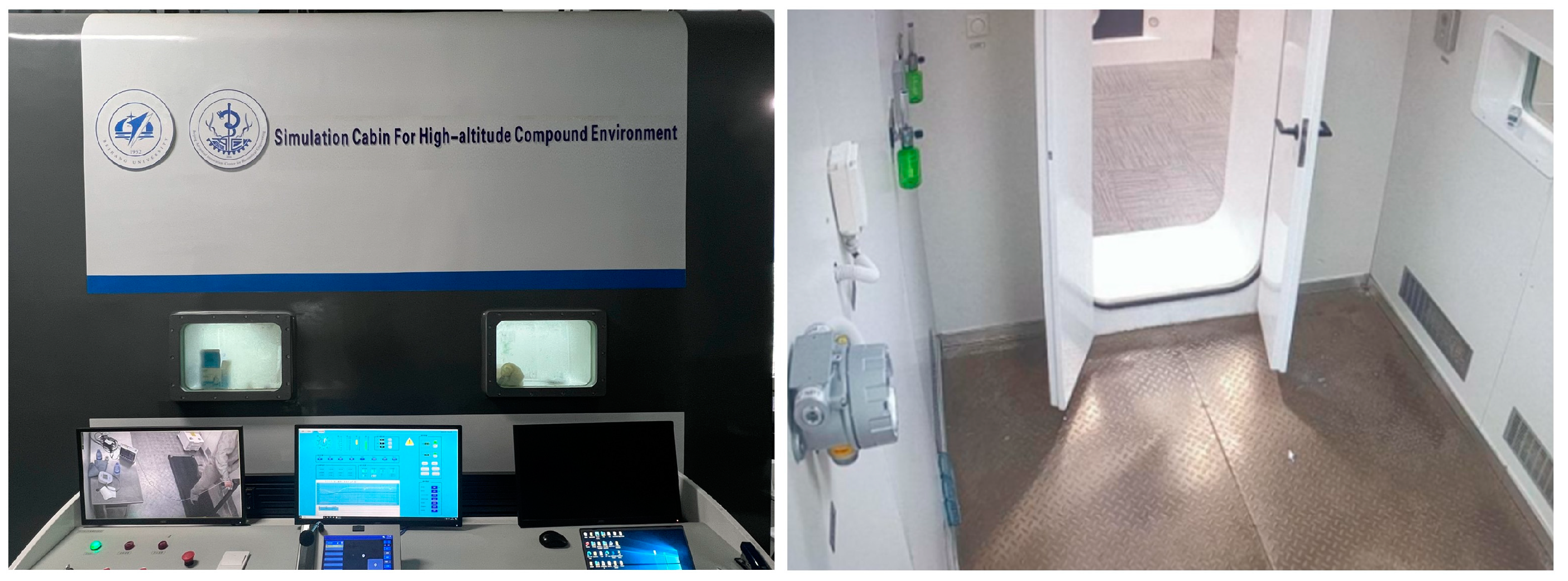

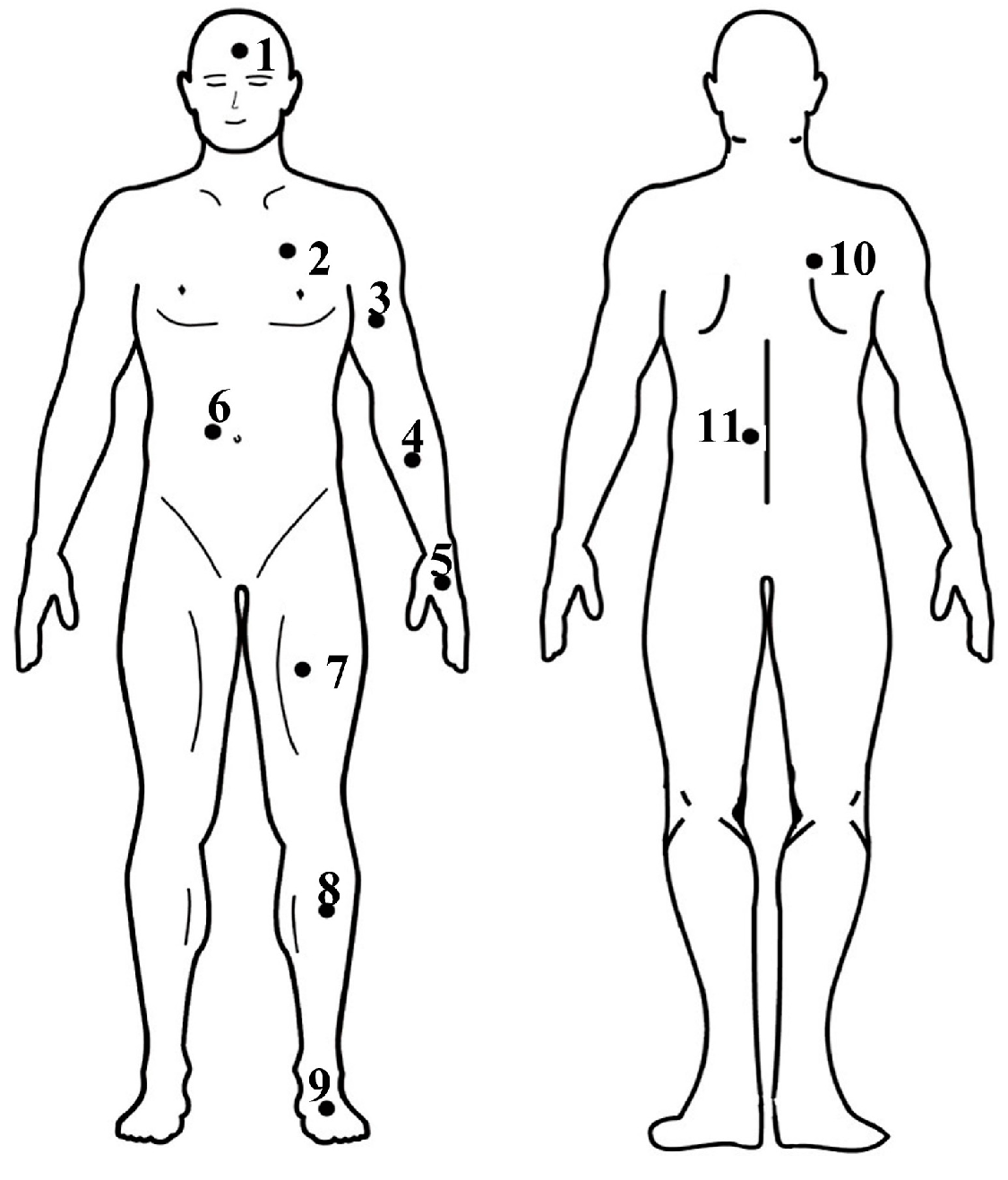


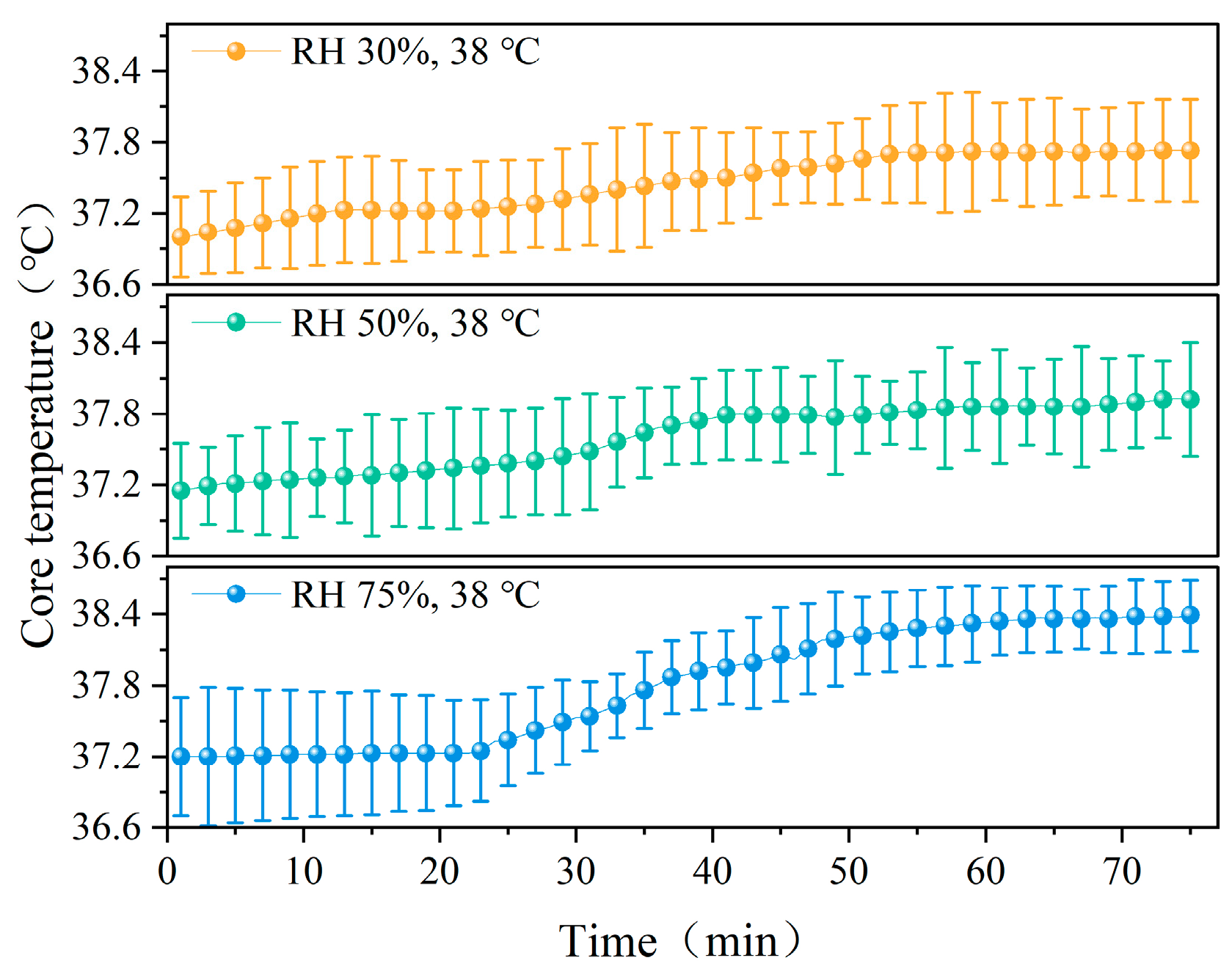
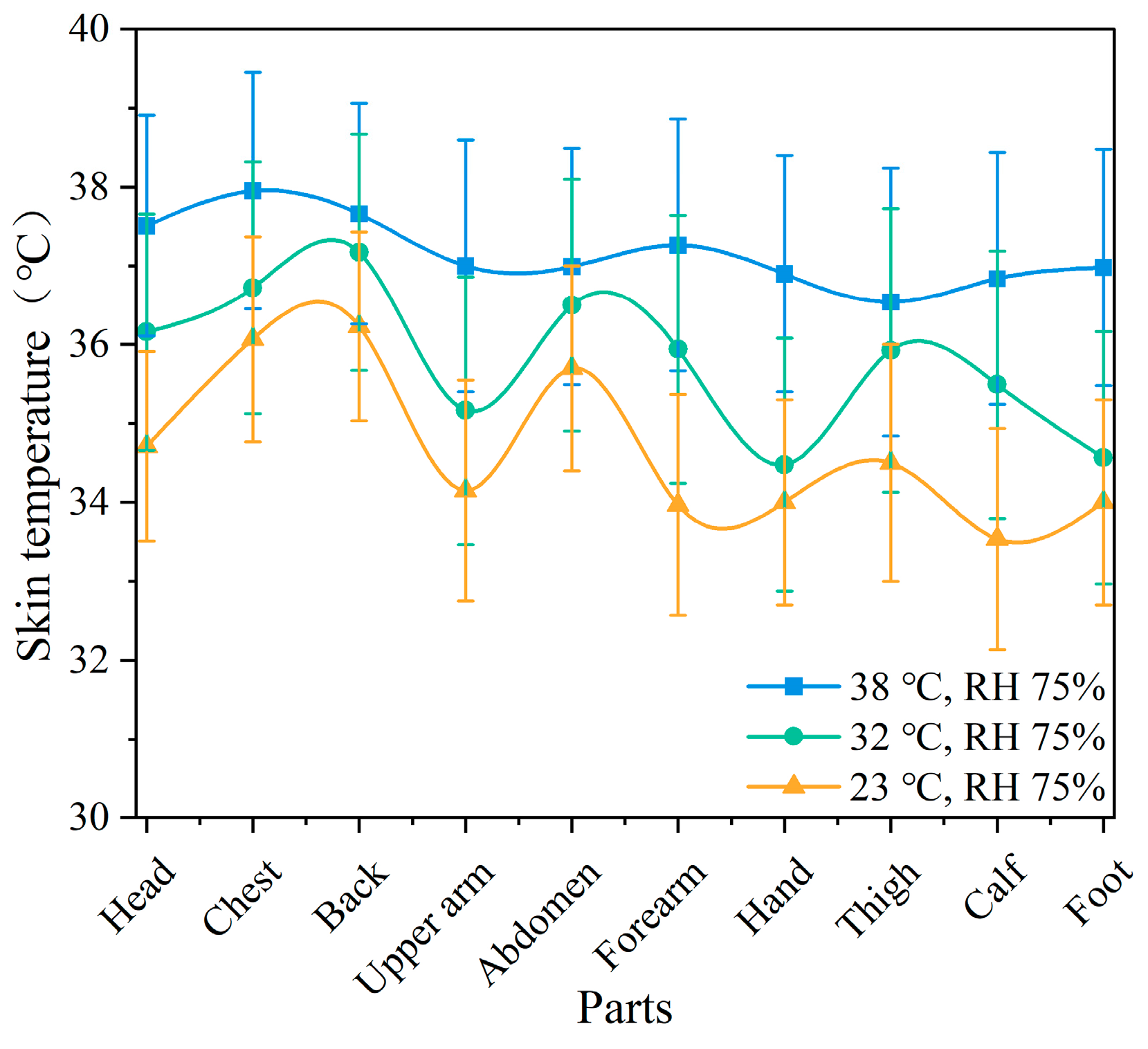
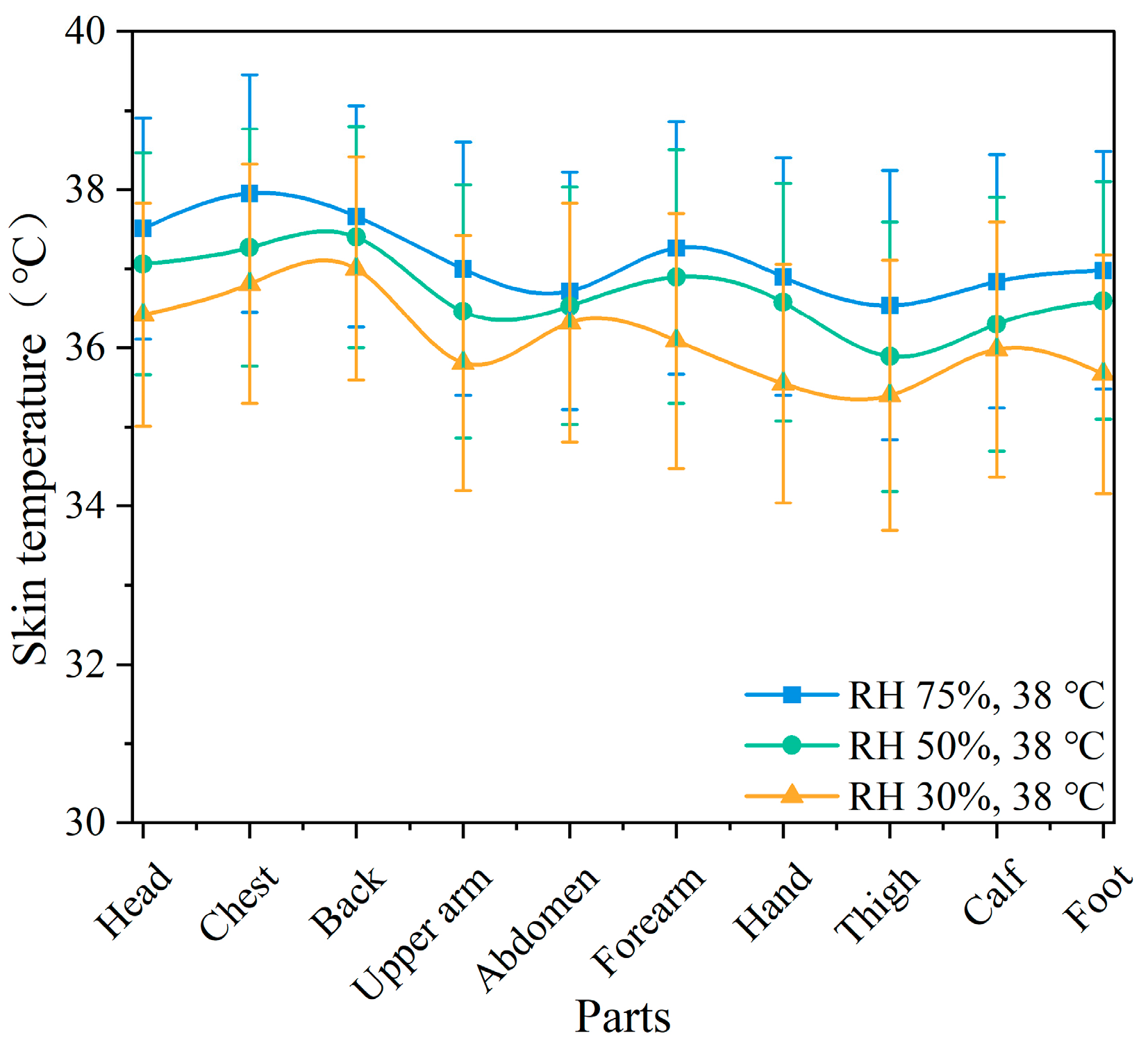
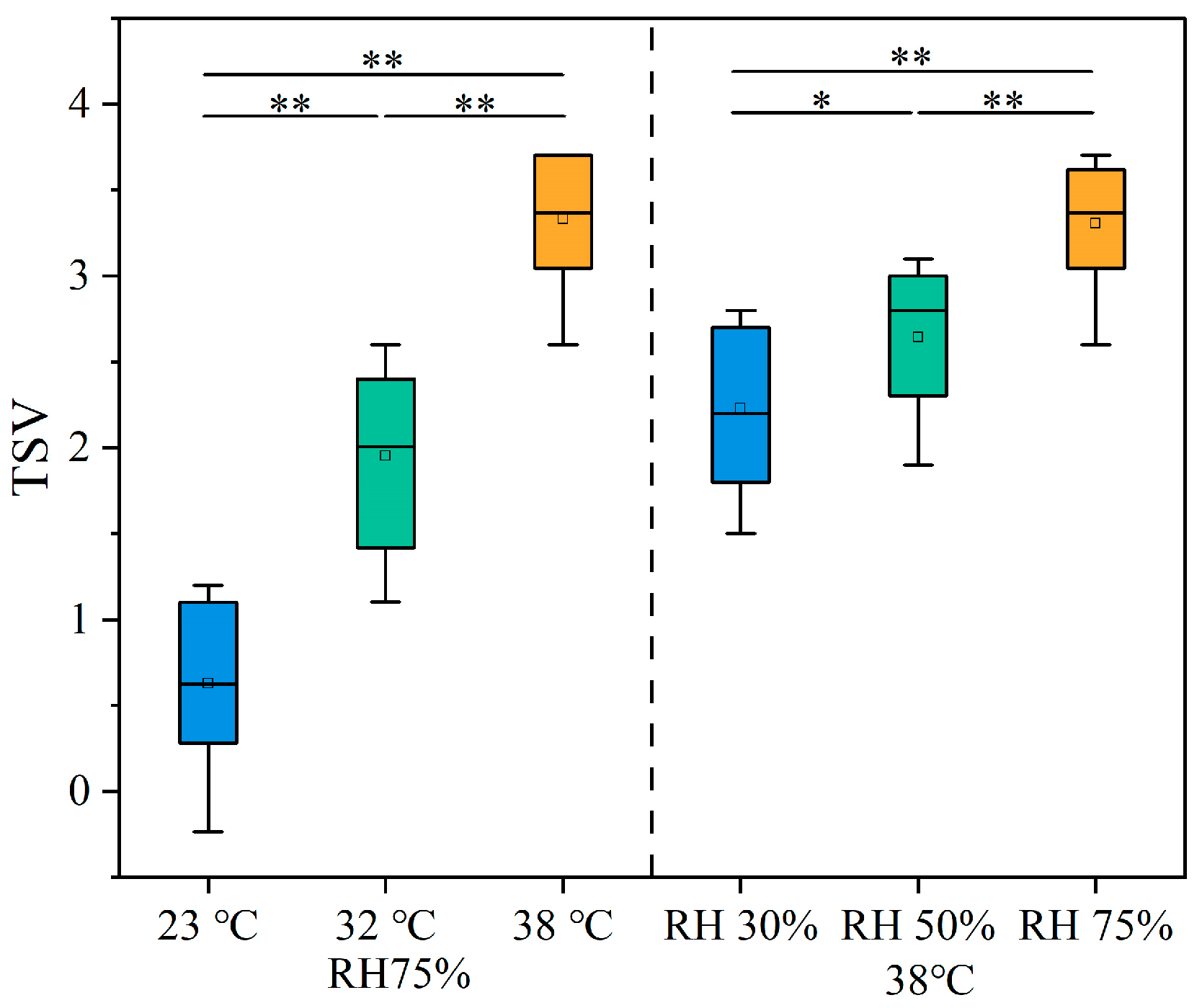
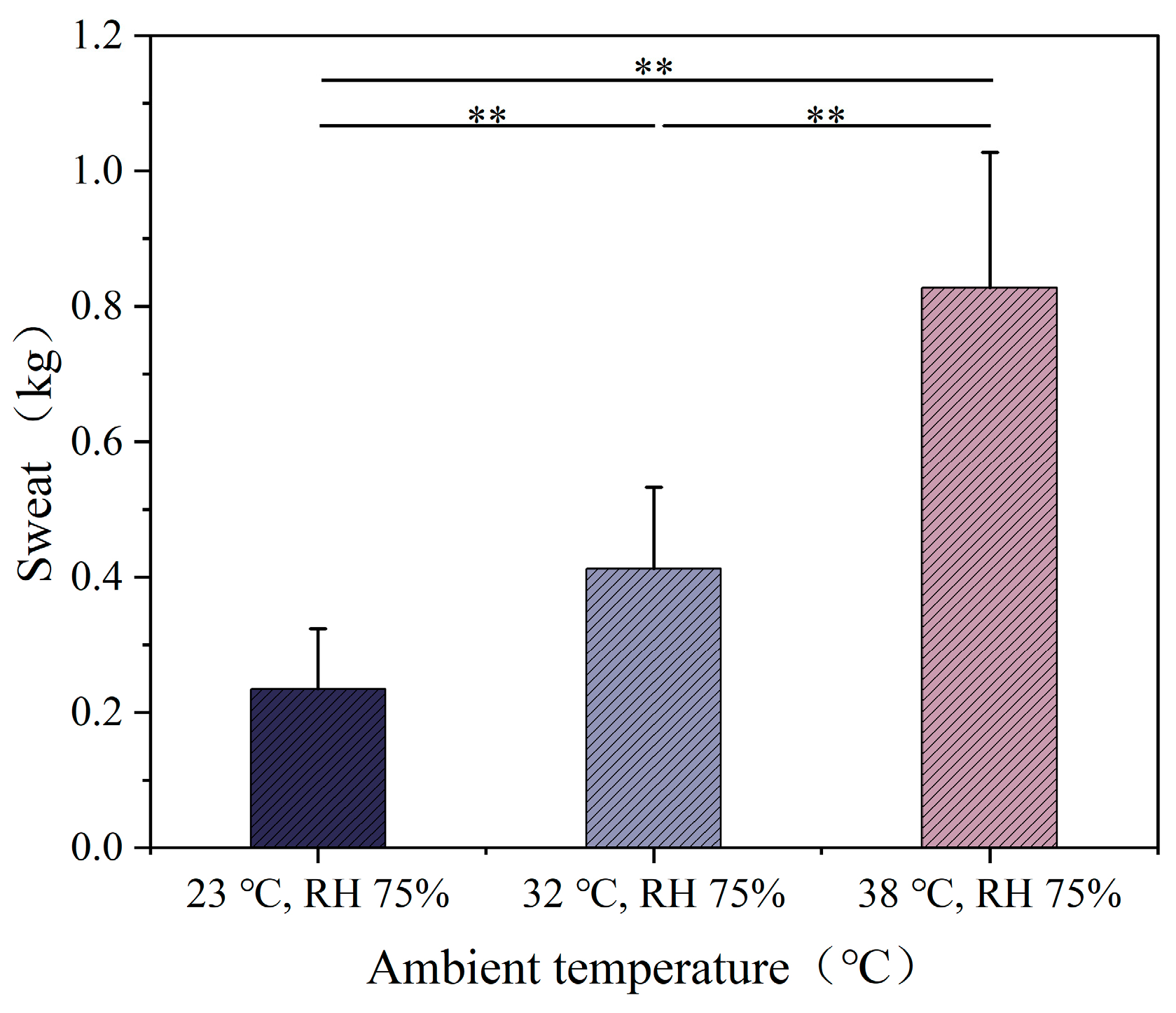
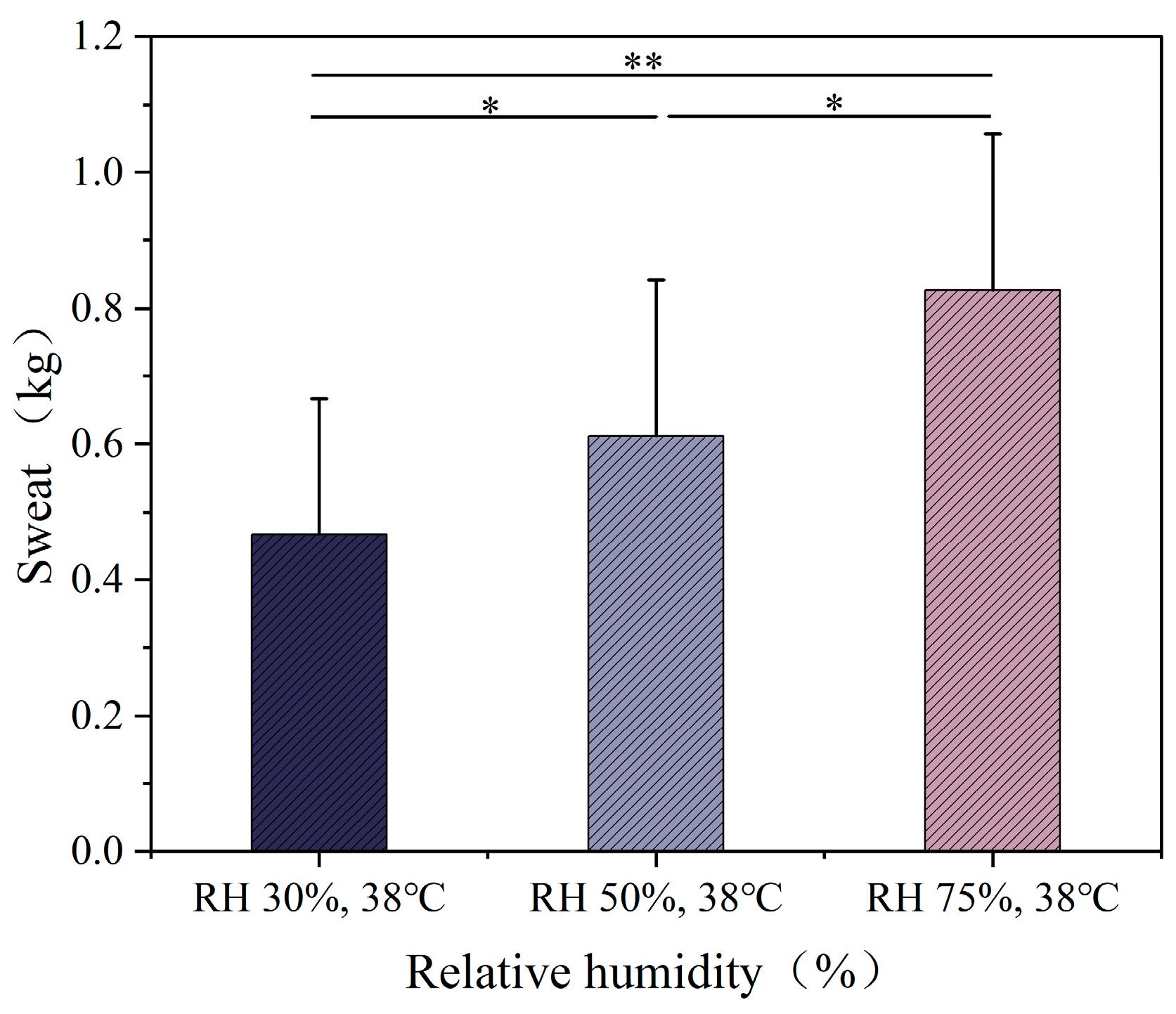
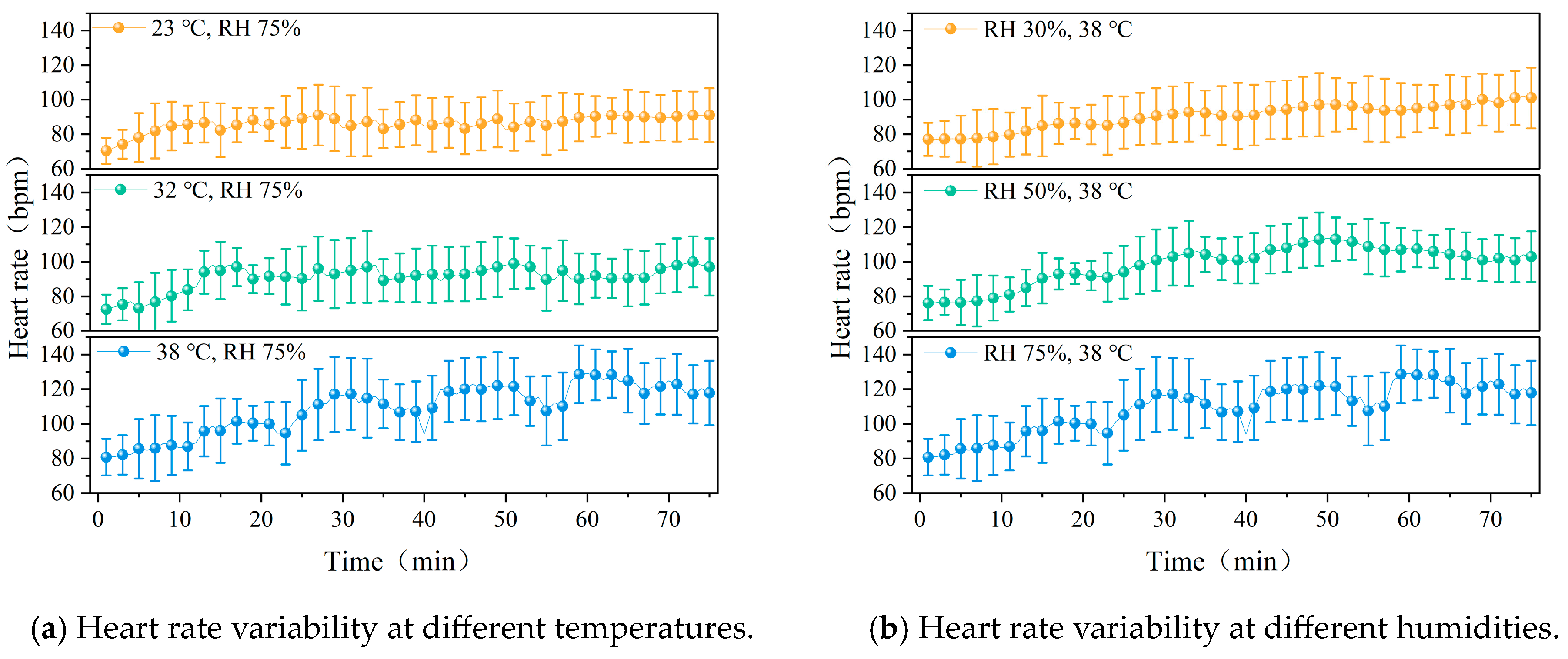
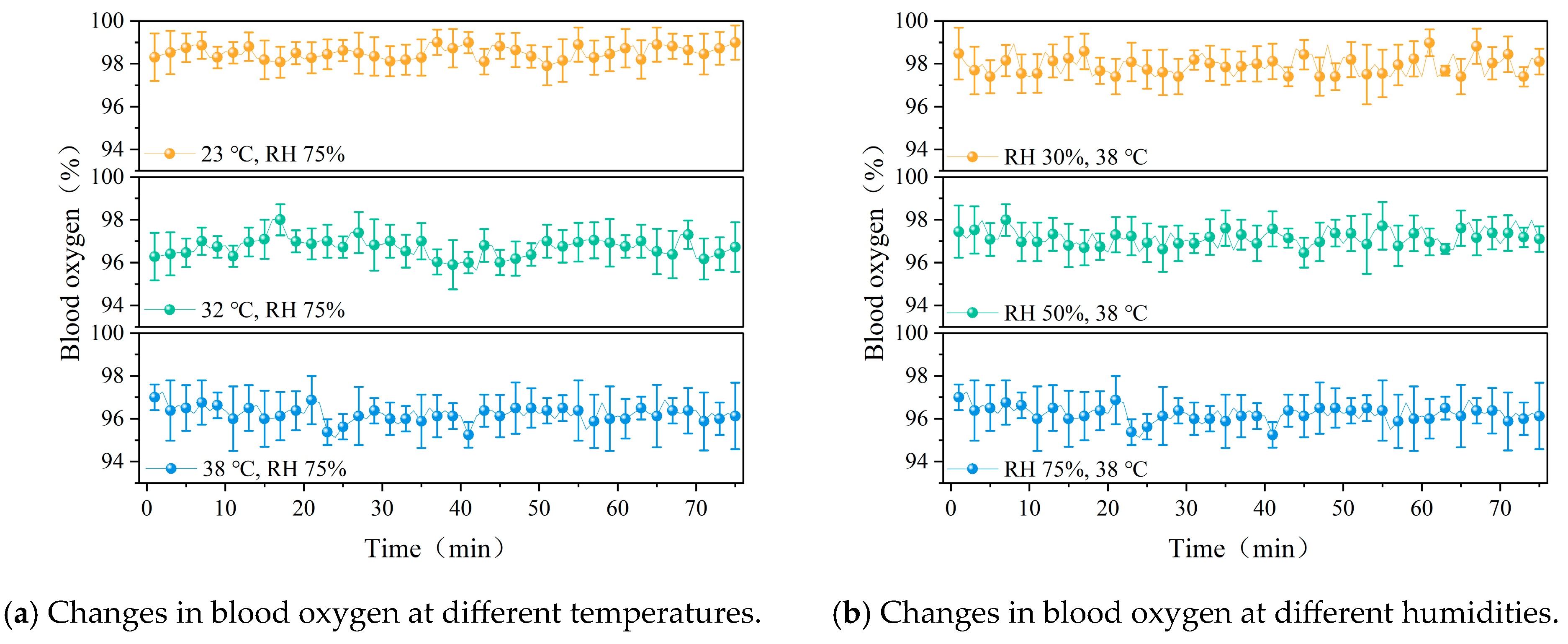



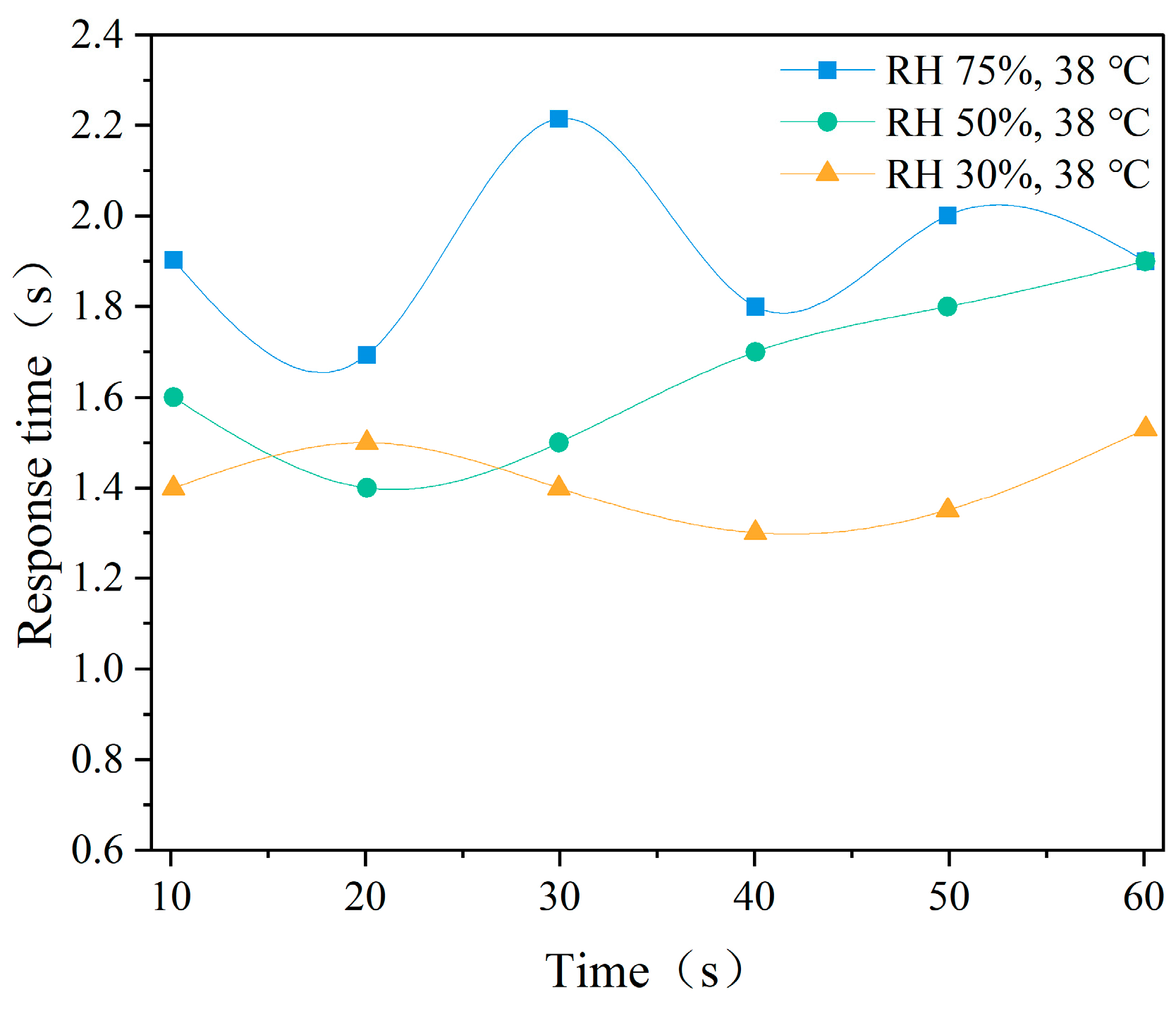

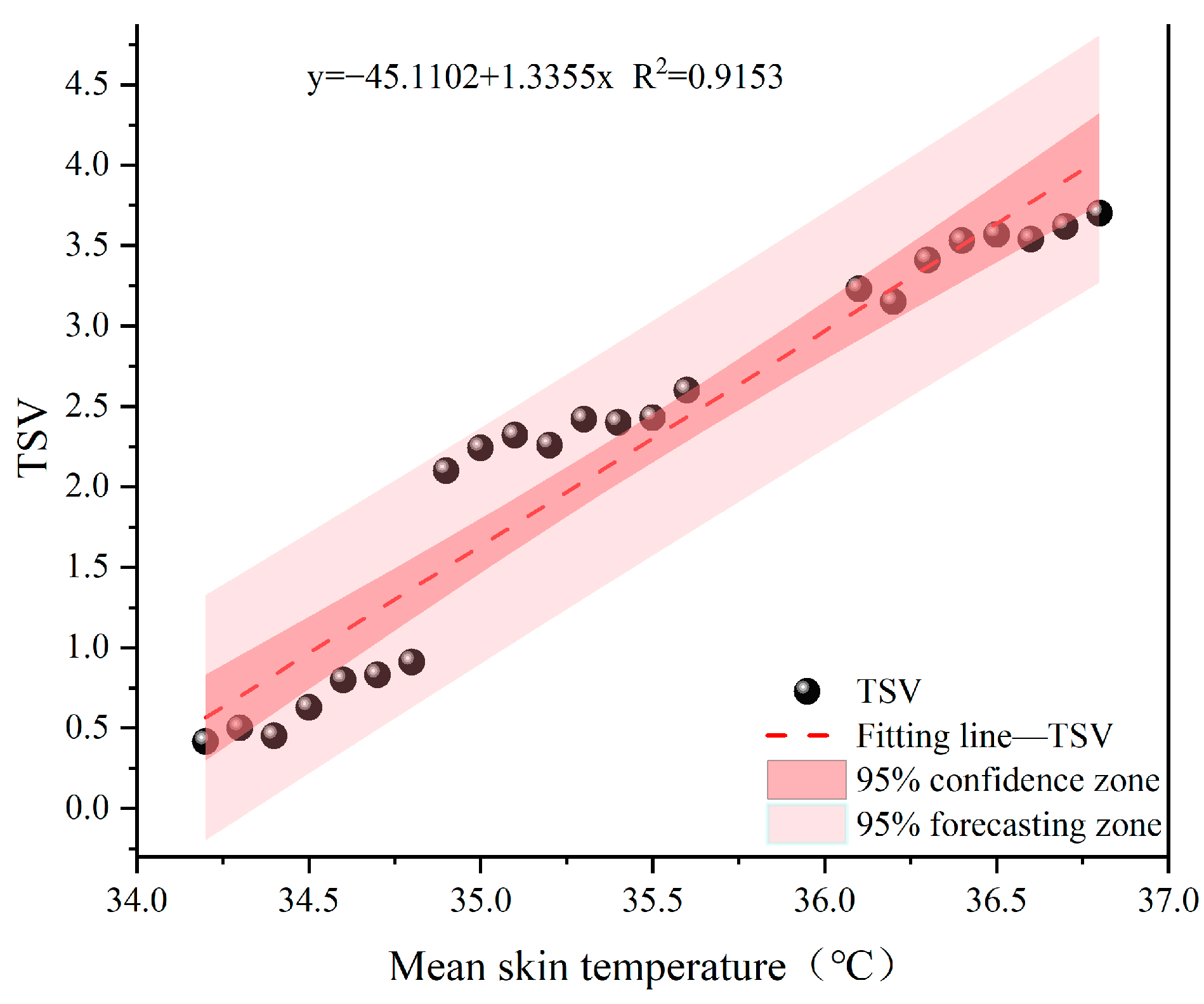

| Ambient Temperature | Relative Humidity | |||||
|---|---|---|---|---|---|---|
| RH 75% | 38 °C | |||||
| Experimental conditions | 23 °C | 32 °C | 38 °C | RH 30% | RH 50% | RH 75% |
| Average skin temperature (°C) | 34.8 | 35.6 | 36.8 | 36.1 | 36.4 | 36.8 |
| Standard deviation (°C) | ±1.91 | ±1.23 | ±0.92 | ±1.12 | ±0.99 | ±0.92 |
Disclaimer/Publisher’s Note: The statements, opinions and data contained in all publications are solely those of the individual author(s) and contributor(s) and not of MDPI and/or the editor(s). MDPI and/or the editor(s) disclaim responsibility for any injury to people or property resulting from any ideas, methods, instructions or products referred to in the content. |
© 2025 by the authors. Licensee MDPI, Basel, Switzerland. This article is an open access article distributed under the terms and conditions of the Creative Commons Attribution (CC BY) license (https://creativecommons.org/licenses/by/4.0/).
Share and Cite
Wang, S.; Gui, X.; Ding, L. Thermophysiology and Cognitive Performance of Live-Line Workers in High-Temperature and High-Humidity Environments. Int. J. Environ. Res. Public Health 2025, 22, 387. https://doi.org/10.3390/ijerph22030387
Wang S, Gui X, Ding L. Thermophysiology and Cognitive Performance of Live-Line Workers in High-Temperature and High-Humidity Environments. International Journal of Environmental Research and Public Health. 2025; 22(3):387. https://doi.org/10.3390/ijerph22030387
Chicago/Turabian StyleWang, Shengwei, Xiaohong Gui, and Li Ding. 2025. "Thermophysiology and Cognitive Performance of Live-Line Workers in High-Temperature and High-Humidity Environments" International Journal of Environmental Research and Public Health 22, no. 3: 387. https://doi.org/10.3390/ijerph22030387
APA StyleWang, S., Gui, X., & Ding, L. (2025). Thermophysiology and Cognitive Performance of Live-Line Workers in High-Temperature and High-Humidity Environments. International Journal of Environmental Research and Public Health, 22(3), 387. https://doi.org/10.3390/ijerph22030387






